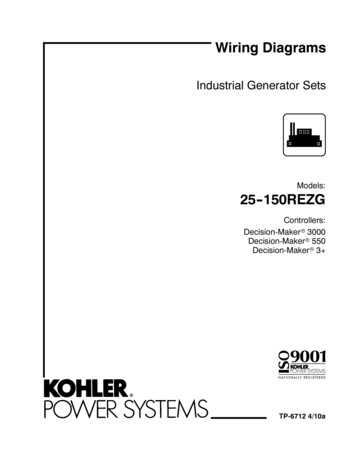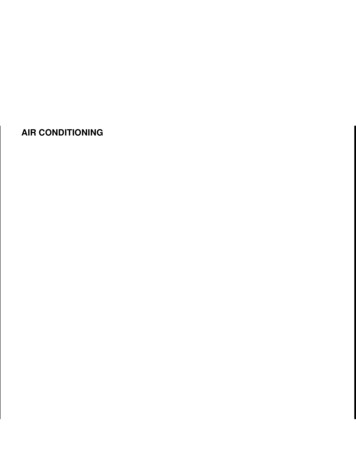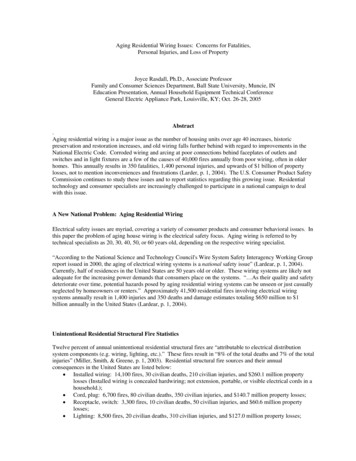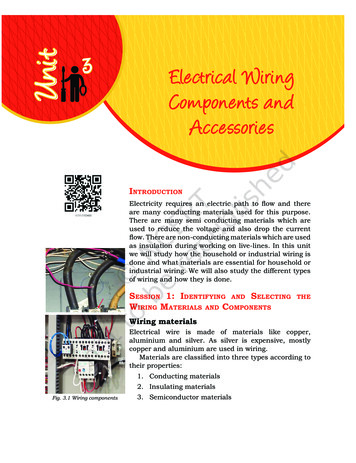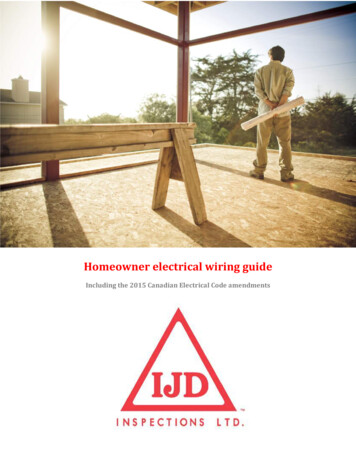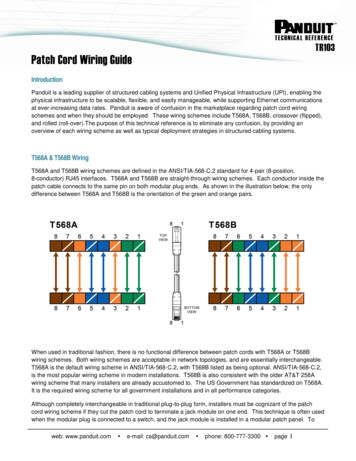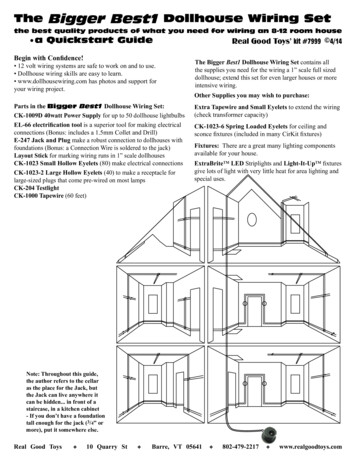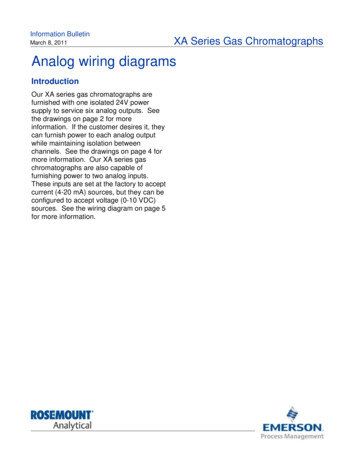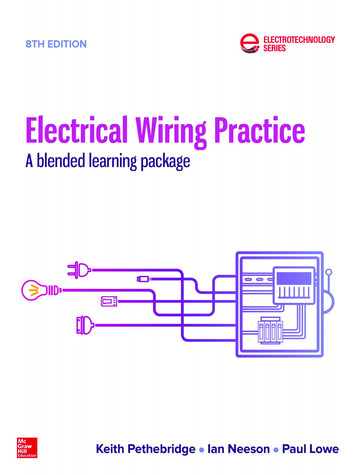
Transcription
ELECTRICAL WIRINGPRACTICEAS/NZS 3000:2018pet21069 fm i-xviii.inddi 09/04/18 12:05 PM
pet21069 fm i-xviii.inddii 09/04/18 12:05 PM
ELECTRICAL WIRINGPRACTICEAS/NZS 3000:2018KEITH PETHEBRIDGEIAN NEESONPAUL LOWE8th EDITIONpet21069 fm i-xviii.inddiii 09/04/18 12:05 PM
Copyright 2019 McGraw-Hill Australia Pty LimitedAdditional owners of copyright are acknowledged in on-page credits.Every effort has been made to trace and acknowledge copyrighted material. The authors and publishers tender theirapologies should any infringement have occurred.Reproduction and communication for educational purposesThe Australian Copyright Act 1968 (the Act) allows a maximum of one chapter or 10% of the pages of this work,whichever is the greater, to be reproduced and/or communicated by any educational institution for its educationalpurposes provided that the institution (or the body that administers it) has sent a Statutory Educational notice toCopyright Agency Limited (CAL) and been granted a licence. For details of statutory educational and other copyrightlicences contact: Copyright Agency Limited, 66 Goulburn Street, Sydney NSW 2000. Telephone: (02) 9394 7600.Website: www.copyright.com.auReproduction and communication for other purposesApart from any fair dealing for the purposes of study, research, criticism or review, as permitted under the Act, nopart of this publication may be reproduced, distributed or transmitted in any form or by any means, or stored in adatabase or retrieval system, without the written permission of McGraw-Hill Australia including, but not limited to,any network or other electronic storage.Enquiries should be made to the publisher via www.mcgraw-hill.com.au or marked for the attention of thepermissions editor at the address below.National Library of Australia Cataloguing-in-Publication entryAuthor: Pethebridge, K (Keith)Title: Electrical wiring practiceEdition: 8eISBN: 9781760421069 (pbk.)Author: Pethebridge, K (Keith)Title: Electrical wiring practiceEdition: 8eISBN: 9781760421069 (pbk.)Published in Australia byMcGraw-Hill Australia Pty LtdLevel 33, 680 George St, Sydney, NSW 2000Publisher: Norma Angeloni-TomarasContent developer: Apeksha RaoSenior production editor: Daisy PatiagEditor: Mary-Jo O’Rourke AECover design: Simon RattrayIllustrator: Ian Neeson, Antony NeesonProofreader: Annabel AdairTypeset in STIXMathJaxMain-Regular 10.5/14 pt by SPi GlobalPrinted in Singapore by Markono Print Media Pte Ltd on 80gsm matt artpet21069 fm i-xviii.inddiv 09/04/18 12:05 PM
PrefaceApproachThe 8th edition of Electrical Wiring Practice continues with the visual format of the 7th edition, with revisionscovering: the knowledge and skills specified in units of competency in national training packages for an electrical tradequalification and advanced trade competencies the Essential Capabilities of the Electrical Regulatory Authorities Council (ERAC) for an electrical licencerelevant to electrical installations and safety extensive referencing to the AS/NZS 3000:2018 Wiring Rules and related Standards.Features of this new edition include: practical applications of the Wiring Rules and related Standards greater use of visual elements that integrate text and graphics to aid learning and teaching expansion of review questions and answers for each chapter.Electrical Wiring Practice employs clear visual elements to illustrate the practices and understanding requiredfor working with electrical equipment and Standards.Although the text is primarily written for students and teachers of electrical trades, it provides up-to-datereference material that will be helpful to many trade professionals.Because so much modern human activity and the goods we produce incorporate electrotechnology, Standardsfor its safety and functionality have become a worldwide concern.The trend towards the development of internationally aligned Standards and the adoption of new methods andmaterials means that compliance Standards are constantly changing.Readers need to be aware that the references to ‘Standards’ in this book are given as guides, with examples oftheir application, but are in no way intended to replace them.Features Figures—There are new and revised figures throughout, with text callouts to provide visual learning aids forpractice and theory. New Standards—The chapters have been thoroughly reviewed to incorporate the latest Wiring Rules andcompliance Standards, and current work practices. Learning objectives—Each chapter begins with a list of learning objectives, giving a summary of projectedlearning outcomes. Introductions—Each chapter begins with a chapter outline. Chapter summaries—Summaries list each chapter’s key points. Review questions—In addition to being useful revision tools for students, these questions can also be used assources for assignments and test questions for teachers and trainers. The solutions to these questions can befound on the Connect website.vpet21069 fm i-xviii.inddv 09/04/18 12:05 PM
Brief contentsChapter 1Electrical energyChapter 2Work and electrical safety19Chapter 3Regulations and Standards49Chapter 4Cables, connections and terminations77Chapter 5Fixing methods and accessories for electricaland data/communications installations121Drawings, diagrams, schedules and documentsused in electrical work151Chapter 7Wiring and cabling systems187Chapter 8Protection—earthing and protective methods245Chapter 9Testing techniques and compliance verification279Chapter 10Electrical protection and protective devices319Chapter 11Electrical installations for safety services—fire protection and evacuation equipment371Renewable energy and other alternativesupply installations395Chapter 13Switchboards, control panels and metering423Chapter 14Installation planning and design—selectingcables and protective devices447Chapter 15Appliances—electric heating and motors497Chapter 16Lighting applications533Chapter 17Damp situations and other specific electricalinstallations571Workshop fabrication597Chapter 6Chapter 12Chapter 181vipet21069 fm i-xviii.inddvi 09/04/18 12:05 PM
ContentsAbout the authorsAcknowledgmentsChapter 1xiixiiiElectrical energy11.11Producing electricity1.2 Electrical energy transmission and distributionChapter 2Chapter 3Chapter 481.3Distribution of electricity to consumers101.4Distribution of electricity in the consumer’s installation10Summary16Work and electrical safety192.1Workplace health and safety202.2Instruction, training, information and supervision222.3Workplace hazards and risk control measures242.4Safety of electrical installations and equipment362.5Hazards of working with electricity392.6Electrical incidents43Summary46Regulations and Standards493.1Electrical licensing503.2Standards503.3Learning the Wiring Rules AS/NZS 3000:2018533.4Using the Wiring Rules593.5Wiring Rules—Clause 1.4 Definitions603.6Fundamental requirements (Wiring Rules Part 1)683.7Insulating materials72Summary74Cables, connections and terminations774.1Conductors and cables784.2Types of cable insulation824.3Power cable classification834.4Power cable types and applications85viipet21069 fm i-xviii.inddvii 09/04/18 12:05 PM
Contents4.5 Power cable termination and conductor connection methods4.6 Data and communications cable types and applicationsSummaryChapter 5Chapter 6Chapter 7Chapter 895108117Fixing methods and accessories for electricaland data/communications installations1215.1Accessories for fixing and support1225.2Mounting brackets, plates and boxes1315.3General switching, lighting and socket-outlet accessories1345.4Protection and control accessories1415.5Accessories for specific situations1465.6Data and communications accessories148Summary148Drawings, diagrams, schedules and documentsused in electrical work1516.1Series and parallel circuits in wiring1526.2Electrical circuits and wiring diagrams1536.3Circuits in general wiring1596.4Undertaking electrical work1716.5Working with specifications, schedules and drawings1776.6Use of software and mobile devices in electrical work180Summary182Wiring and cabling systems1877.1 Wiring and cable routes through buildings and structures1887.2Wiring and cabling systems1947.3Installing wiring systems1977.4Enclosed wiring and cables2087.5Underground systems2317.6Aerial and catenary systems2347.7Composite wiring systems and applications236Summary240Protection—earthing and protective methods2458.1Reasons for an earthing system2468.2Earthing systems2518.3MEN earthing system2548.4Earth faults2608.5Earthing system—selection and installation2648.6Other protective methods272Summary275viiipet21069 fm i-xviii.inddviii 09/04/18 12:05 PM
ContentsChapter 9Chapter 10Testing techniques and compliance verification2799.1Testing safety2809.2Testing principles2849.3Testing devices2889.4Verification and compliance2959.5Fault-finding and performance testing309Summary315Electrical protection and protective devices31910.1 Protection against overcurrent32010.2 Overcurrent protective devices33110.3 Protection against indirect contact with live parts34810.4 Protection against overvoltage and undervoltage36010.5 Protection arrangement and discrimination365SummaryChapter 11Electrical installations for safety services—fire protection and evacuation equipment37111.1 Fire safety in buildings37211.2 Fire safety Standards, regulations and systems37511.3 Fire detection and alarm devices—residential premises37911.4 Fire protection systems—non-domestic premises385SummaryChapter 12393Renewable energy and other alternativesupply installations39512.1 Renewable energy sources within a consumer installation39612.2 Alternative supply systems40912.3 Standalone power systems41112.4 Inverter systems41212.5 Battery systems41612.6 Uninterruptible Power Systems (UPS)418SummaryChapter 13368420Switchboards, control panels and metering42313.1 Compliance requirements for switchboards42413.2 Applications of switchboards in the arrangementof electrical installations43213.3 Control panels43413.4 Electrical energy markets and metering43613.5 Energy metering arrangements438Summary446ixpet21069 fm i-xviii.inddix 09/04/18 12:05 PM
ContentsChapter 14Installation planning and design—selectingcables and protective devices44714.1 Factors affecting installation design44814.2 Arranging an electrical installation into circuits45214.3 Factors affecting cable selection45514.4 Determining maximum demand47014.5 Selection of minimum cable size based oncurrent-carrying capacity47914.6 Selection of minimum cable size based on voltage-drop andearth fault-loop impedance (EFLI) limitations48214.7 Short-circuit temperature performance of cables493SummaryChapter 15Appliances—electric heating and motors49715.1 Appliances and accessories—installation requirements49815.2 Heating methods and control49915.3 Water heating50615.4 Heating systems51615.5 Process heating52115.6 Motors528SummaryChapter 16531Lighting applications53316.1 Basic lighting principles, terminology and units53416.2 Elementary lighting design54016.3 Incandescent lamps54516.4 ELV lamps54716.5 Gas-discharge lamps54816.6 Fluorescent lamps55316.7 LED lighting55516.8 Comparison of light sources55916.9 Luminaires and lighting circuits561SummaryChapter 17494568Damp situations and other specific electricalinstallations57117.1 Electrical enclosures—ingress protection (IP)57217.2 Damp situations57417.3 Installations for hazardous areas58017.4 Installations for transportable structures and sites58417.5 Shows and carnivals58617.6 Medical treatment areas586xpet21069 fm i-xviii.inddx 09/04/18 12:05 PM
Contents17.7 Marina electrical installation59017.8 Construction and demolition sites59217.9 High-voltage electrical installations594SummaryChapter 18595Workshop fabrication59718.1 Workshop safety practices59818.2 Tools used in electrical work60018.3 Materials used for custom components60418.4 Job planning60618.5 Cutting and shaping62118.6 Drills and drilling62718.7 Thread cutting and tapping63118.8 Joining components63518.9 Dismantling and assembling 9 fm i-xviii.inddxi 09/04/18 12:05 PM
About the authorsKeith PethebridgeKeith Pethebridge, a passionate teacher and mentor, sadly passed away in March 2010. However, his insight andcommitment, going as far back as the 1970s, to creating a text devoted to electrical wiring lives on. Now in itseighth edition, Electrical Wiring Practice can be regarded as Keith’s legacy to the electrical industry. Thanks, Keith.Ian NeesonIan Neeson is a vocational education and training consultant specialising in electrotechnology.He was involved in the development of the National Competency Standards forElectrotechnology and continues to provide assistance to the National ElectroComms andEnergy Utilities Skills Council (EE-Oz Training Standards) in its program of continuousimprovement.Ian also represents the National Skills Council on the Wiring Rules Committee (EL-001)and Hazardous Areas Competency Standards Committee (P-12). He is a member of an IECExWorking Group for Personnel Competencies. For the past few years, Ian has also been a member of the judgingteam for the National Electrical and Communications Association (NECA) NSW Excellence Awards.Paul LowePaul Lowe has been involved in the electrotechnology field for over 35 years. During the past14 years Paul has worked for TAFE NSW as a teacher, head teacher and, more recently, asIndustry Liaison Manager responsible for electrotechnology across NSW.He has been an active participant in the development of training package qualificationsand units for the last six years and is a member of several technical advisory committees,representing NSW in the National Technical Advisory Group. He is currently part ofthe Commonwealth Industry Skills Committee as a technical expert, representing theElectrotechnology Training Package.xiipet21069 fm i-xviii.inddxii 09/04/18 12:05 PM
AcknowledgmentsThe production of a book covering such a wide range of topics would not be possible but for the contributions madeby members of the electrotechnology industry in Australia and New Zealand. Our thanks go to these groups andorganisations, who are listed below and cited throughout the text: ABB RoboticsBoutique PowerClipsal, Schneider ElectricEDMIEmona InstrumentsFuji SMBE HarwalHeyday GroupNational Electrical and CommunicationsAssociation (NECA) NATSPEC Olex CablesPhilipsPowerGen AustraliaRedflowSAI Global LtdSelectronicStand Alone Power SystemsStandards AustraliaTeslaPermission to reproduce the cover of AS/NZS 3000:2018 given by SAI Global Ltd. This Standard can be purchasedonline at www.saiglobal.com.The development of this edition would not have been possible without the help and encouragement of ourcolleagues in vocational education and training and in industry. Particular thanks go to Antony Neeson for hisartistic prowess.We would also like to thank the publishing team at McGraw-Hill for their hard work throughout the productionof this book: Norma Tomaras, Apeksha Rao and Daisy Patiag.Keith’s legacy lives on.Ian Neeson and Paul Lowexiiipet21069 fm i-xviii.inddxiii 09/05/18 11:14 AM
Work and electrical safety Chapter 2INFORMATION, TRAINING AND INSTRUCTIONYour employer is required to provide a healthy and safe workplace. The very nature of maintaining a healthy andsafe workplace means that training must be ongoing. Familiarity and complacency can pose the highest risk. Itdiagrams,schedulesandinformationdocumentsin electricalworkChapteris commonly the roleDrawings,of an immediatesupervisorto provide clearandusedinstructionon the workathand and be satisfied you are trained to do the work in the role you are given. The emphasis being on safetyengaging with this through pre-start and tool-box talks. Once started on a worksite some of the most importantP3P3P3things are:222possible hazards and unsafe situations particularly in unfamiliar work environments and the safe workmethods to be appliedreceive clear P3VP2VP4understand and accept the safe work methods to be usedM work method statementMPPP to be used asMprescribed in the safe(SWMS) or jobM safety analysis (JSA)L3participatein any safety discussionL1L2Text at a glanceElectrical energyLearning outcomest ppMLCSUPERVISORSAdditional WHS training is provided for supervisors as they needa greater understanding of workplace hazards and control measures.This is particularly important for supervising apprentices.12ApparatusCableInformation boxesLPDB2P3Cables, connections and terminations Chapter 41 3 C E 70 mm2 R-HF-110 sheathed cableVacuum pump powerSupport/protectionCable ladderMLCMotor Load CentreLPDB Light and power distributionTable 4.1mustComparison of copper and aluminiumspecificconductorselectrical work, as summarised in Figuretraineesboard 2.2a, which are a1 8 C E 1.5 mm2 R-HF-110tosheathedcableand control undertake WHS competenciesVPVacuum pumpprerequisiteto all other competenciesrequired in order to achieve theCablestatusof ‘electrician’.1 3 C E 10 mm2 R-HF-110 sheathed cableladderCooling water pumpsFeaturesCopper conductorAluminiumconductorCWP Cooling water pumpAs shown in Figure 2.2a, WHS induction2 continues with the enterprise you work for and, over time, as electricalCable ladder2 4 C 1.5 mm R-HF-110 sheathed cableVacuum pump localLLight aveitsowninduction,whichwillcoverat a minimum ancontrols materialConductorMade with a high degree of purity exceeding 99.5%PPower circuitorientationto the workplace layoutand facilities, and any specific hazards.HFT conduit50W LED low bay pendant2.5 mm insulated cables and earthLight and powerHighertensile strengththan aluminiumOne-thirdtheonweightof copperFurther to this, workinformationand trainingrelated to safety areprovidedan ongoingbasis, and you areobligated to participate in this, as summarised in Figure 2.2b.These box features highlight dangers, hazards andinformation that students should be aware of in the field.Figure6.4f Architectural/engineer’s electrical plan of a plant roomConductivityApproximately 60% that of copperCurrent-carryingcapacityAbout 80% that of copper for the same sizeconductor6.5Working with specifications, schedules and drawingsCAUTIONSusceptibility tocorrosionResistant to corrosion in unpollutedenvironments, but affected by ammoniaA surface oxide forms on aluminium that has avery high resistanceElectrical workersandin sulfurserviceor maintenance roles will often find themselves in unfamiliar workingfumesAt some point in your career, you may choose to move into job supervision, leading to project management orenvironments. Each time electrical workers encounter an unfamiliar workplace, they should requestestimatingpreparation,where youwill work more closelywithspecifications.However,the mostJoiningandand movedandan orientationon Canthe behealthandsafetyorhazardspresent, and theproceduresfor becontrollingthe risk ofimmediateforanya persontraining is extractinginformationas a startto learningterminatinguse of specificationsjoined withoutspecial inprecautionspreventedfrom formingbetweenjointed to planillness or injury in the unfamiliar environment.surfaces with a neutralising paste; the high– explain the principles for producing electricity– explain the reasons for the adoption of alternating current (a.c.) for the main electricity powerLEARNINGOUTCOMESsupply system– describe the advantage and applications of modern direct current (d.c.) transmissionAfteryou thecompletethischapterand thelearningexperiences,– identifyconductorsandtheir purposein a relevantthree-phasedistributionsystemyouwill behowableto:– illustrateelectricityis transmitted and distributedbasic legalrequirementshealthand safety in the workplace—– describeillustrate the differentarrangementsofcoveringdistributionto consumers—steps in managinghealthand safetywithinrisk inantheworkplace– explaindescribethethebasicarrangementsfor aininginstruction requirementsmust be undertaken– outlinediscussthethesafetyprocessesfor andthe connectionof electricity tothata consumer’sinstallationbeforeand thestartingwork activityneed foranycompliancewith safety standards.— identify common potential workplace hazards and typical measures for accident prevention— follow safe work methods for personal safety in the workplace— identify the types of personal protective equipment needed for a particular task— work safely with hand and electrical tools— describe the method for ensuring that an electrical installation is safe to usethe purpose ofelectricitythe earthing system1.1— explainProducing— safely and correctly connect flexible cords and extension leads— outline the reasons for special precautions for installations in damp areasRegulations and Standards Chapter 3— describethe risksandproducedcontrol measureswith high-voltage,low-voltage,extra-lowThe bulkof electricalenergytoday is associatedobtained froma rotating turbineattachedto an electricalChapter introductionEvery chapter commences with an introduction tovoltageandhigh currentsgeneratorthat useselectromagneticinductionto produceenergy(Figure1.1a). Energyused sallows formuchmoreinnovationin installationdesign,at the— demonstratesafeproceduresrescueof a victimof low-voltageelectricshockis extractedfrom steam,flowingwater, forhotthegasesand wind.In Australia,as theyin manyothercountries,the primesametime requiringa completeunderstandingof electricalprinciplesand howapply,particularlyin relationto—demonstratethe applicationof CPR isforcoal.an ewableconceptstoandbein the text.providing protectionsafetycoveredin electrical installations.energy sources driven by the need to reduce greenhouse gas emissions from burning fossil fuels. In a numberThis 2000 edition was criticised for the absence of information that had been in previous editions that helped inof other countries,nuclearenergytheis 2007the primesource.Althoughare similarin manyapplyingthe Standard.As a result,editionand nowthe eguidanceonrespectsto otherthermalpower stations,are identifiedseparatelybecause of the additional equipmentways to complywiththe fundamentalsafety theyperformanceprinciplesof the Standard.requiredto controlthe process,thein associatedrisk isofonea nuclearaccidentand theproblemsof nuclearwasteLearninghow to achievesafetythe workplaceof the mostimportantaspectsof yourvocationalcontainment.training and education, and you will continue to put this knowledge into practice throughout your workingAdditionally,therearemultiplemany smallgenerators for electricity supply in areas remote fromlife.Electricianshaverolesdieselwhen engine-drivenit comes to safety.main powerprevalentas standbysupply orks.they mustThesecarry areoutbecomingtheir workmoresafelyand observeall measuresto protectthemselvesthatandelectricityproducedfor themain powernetworkis alternatingcurrent,which hashazards,some distinctadvantagesfellow workersagainstworkplacehazards.In additionto commonworkplacethey mustalsooverdirectdealwithcurrent.the dangers of working with electricity. This requires an understanding of the use of work safetypracticesand KNOW?how safety is managed in the workplace, including a willingness to cooperate with otherDID YOU1workers to recognise and deal with health and safety risks.Secondly,electricianshaveliabilityto ensurethat the electrical systems and equipment they installThe best way to learn howtoausethe WiringRulesand maintain are safe and remain safe for all those who use them. This requires a thorough knowledge ofStart with the 1‘Content’, as illustrated in the following Figures 3.3a to 3.3e. You will see that the09/04/18Wiringpet21069 ch01 001-018.indd11:20 AMelectrical principles,the Wiring Rules and regulations, and the skills to apply this knowledge.Rules follows a logical plan. The Rules commence at the supply end of the installation through toIn addition to this, if an accident does occur, those able to give assistance should know how to rescuerequirements for the selection and installation of wiring, equipment and earthing; these are followed bya victim safely and how to apply emergency treatment.requirements for special types of installations and then verification by inspection and testing. It finisheswith Appendices for information and guidance in applying the requirements of the Standard. Althoughtackling the Wiring Rules may seem difficult at first, by viewing the eight sections as a series of eight 19separate books (with the Appendices as the ‘help’ file), the task of using it will become much easier.The Wiring Rules also includes an index which should only be used once you have become adept atreferencing information from the content.pet21069 ch02 019-048.indd 1908/07/18 12:08 PMLearning the Wiring Rules AS/NZS 3000:2018ExercisesThroughoutthe bookarewrittena number of exercises for3.3.1 How the WiringRules areThe Wiring Rulesto(commonlyknown as knowledge.‘the Rules’) are written in the form of clauses designated by a pointstudentstest theiran installation. You will probably start with a small component of an installation, say, the installation of a finalcoefficient of expansion must be consideredsubcircuit. Initially this will require the compiling of a materials list.when joining and terminatingIn planning an installation and compiling a materials list, the correct interpretation of the plans, specificationsand/orschedules is of fundamentalimportance.mustwiringbe familiarAwiththelighterstandardusedandin plans;ApplicationThe most commonlyused inYougeneralmuchmetalsymbolsthan copperso a anyThe continuingneedto worksafely meansthat youare planobligatedto keepupdatingyour cablesWHS knowledge.popularconductorfor aerialnon-standardisedonesshouldbe containedin a legendon theitself.Updates are easily obtained through the relevant authority websites, given at the end of this chapter.Usedsolid conductorsin large sizesConductorsize you haveFor ageneralwiring, sizea single-wireRemember,responsibilityto ofworksafely bycopperfollowingtheforcorrectsafety proceduresat allastimes.softer than copper and bends more easilyconductor is not more than 2.5 mm2 (1/1.78).If you believeyouPracticeareLargerbeingsolidexposedto a hazardElectricalWiringconductorsused in withoutmineral- sufficient controls in place, or you have any doubtsATTENTIONabout health and safetyin yourmetal-sheathedworkplace, youare entitledto forraise the issue with your supervisor or employeeinsulated(MIMS)cables andbusbars, some earthing conductors, trolley andrepresentative.Don’t rely on memory—write it down. Even on small jobs, several weeks can pass between roughing in thecollector wireswiring andfitting out. If the jobis a renovation,the cableroutesyou wouldmeasuresnormally use in a new structure2.3Workplacehazardsandriskcontrolmay not be accessible, often resulting in convoluted cable runs. A record in a job notebook and on a planof what you intend to do and what you have done can save a lot of time and prevent costly mistakes.23many strands of thin wire. The conductor of a cable core can be single-strand or multistrand, while the cable itselfA commitment to work safety starts with the enterprise undertaking the work, be this a small or large company orcanbe single-core 23or multicore.pet21069 ch02 019-048.indd08/07/18 12:08 PMeven a sole trader. The commitment is usually reflected in a written policy about how the enterprise will manageBoth copper and aluminium cables use stranded-type conductors, although aluminium conductors are more177WHS and related aspects like risk.commonly solid-core, and are cheaper and easier to join but less flexible than stranded cables. Some large copperMany industry bodies provide advice on managing WHS including templates for risk management policycables for special uses have their flexibility increased by bunch stranding or rope lay.and safe work method statements (SWMS). The National Electrical and Communications Association (NECA)has developed a number of these documents that are applicable to the electrotechnology industries. Although atpet21069 ch06 151-186.indd 17708/09/18 01:35 PMthis stageof yourapprenticetraining you will have limited levels of knowledge and skills in electrical work, it isAS/NZS3008.1SERIESimperative that you understand the hazards and risks, and follow all safety instructions and requirements.Table2.1 outlinessome of the moreofimmediatemanagementpoliciesand ctioncables Part1: Cables foralternatingvoltagesup to and by NECANSWincludingwith regards0.6/1toksafety.VThis importantStandardrulesgives all the information about cables and, together with the Wiring Rules, is2.3.1Lifesavingused by electricians when planning electrical installationCables,work. It is publishedandas Part 1.1 for Australian4The conditionslifesaving rulesare a1.2setforofNewrulesZealandthat are conditions.intended to be strictly connectionsapplied across allterminationsworksites andChapterthat relateand Partspecifically to high-risk activities.as eandneutralfunctionsofconductors;however,These rules are an industry benchmark and are reviewed by NECA NSW, together with other organisations.aCables easedmayflexibility1.4.24)aretermed flexiblecables,conductorwitharegreen/yellow,or yellowbe(Clauseusedundercircumstancesas anactiveandorThey are designedto protect employeesand contractorsfromnotseriousinjuryor anydeath,and have beenadoptedbytheir flexibilityis achieved with a conductor of many small-diameter strands. For example, a
6.1 Series and parallel circuits in wiring 152 6.2 Electrical circuits and wiring diagrams 153 6.3 Circuits in general wiring 159 6.4 Undertaking electrical work 171 6.5 Working with specifications, schedules and drawings 177 6.6 Use of software and mobile devices in electrical work 180 Summary 182 Chapter 7 Wiring and cabling systems 187
